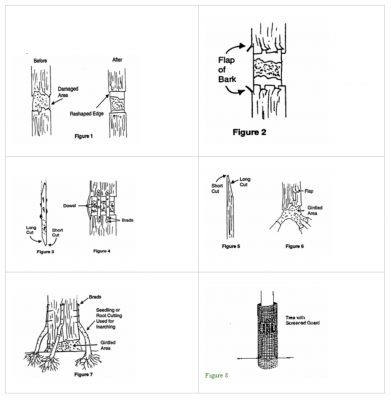Bridge-grafting and inarching is used to repair trees that have been girdled by mice, rabbits, other rodents or by mechanical injury. Bridge-grafting consists of connecting the cambium layers above and below the girdled area. This process restores the flow of carbohydrates from the leaves down to the roots, thereby allowing the tree to continue its normal life processes. The connection or bridge is usually made with scions. However, uninjured suckers growing from the base of the tree may be inarched or young trees can be planted near the base of the tree and inarched. Trees normally grafted in this manner are apples, pears, walnuts and cherries.
First Aid for Girdled Trees
Partially or completely girdled trees should be protected to prevent drying out of the wood by covering the wound with grafting wax or a water-base asphalt emulsion or asphaltum material. The protection may also help prevent small pieces of remaining living bark from drying out which may then heal, thus helping the tree to survive. Do not use roofing tar, oil base paints or other oil-based products as they will only injure the tree further.
Collecting the Scions (Bridge Wood)
Scions (the piece that will form the bridge) must be collected while the wood is dormant. The scions must be of the previous season’s growth and should be about the thickness of a pencil. Store them in a sealed plastic bag in the refrigerator. The scions must be of the same or compatible species.
Materials Needed for Grafting
The following material will be needed to complete a bridge graft.
- Previously collected scions.
- Grafting wax or water-base asphalt emulsion to protect the grafts from drying out.
- A sharp knife to shape the scions, trim the wound and cut the bark.
- Small brads about one inch long to hold the scions in place.
- A short block of wood or dowel 3/4 of an inch in thickness to help form a bow.
Time to Graft
Sometime after the buds begin to swell in the spring, the bark will peel back or slip easily. The tree is now ready to be grafted. Growth is going on at this time and the scions are less likely to dry out. Occasionally scions are inserted during the summer to replace some that failed.
Preparing the Wound for Grafting
Trim loose and dried bark from the tree. Reshape the girdled area so as to leave a smooth edge. It does not have to be straight across the tree but can be gently curved to follow the shape of the wound. See Figure 1.
Mark two parallel cuts in the tree bark about two inches long and the width of the scion. Remove about 1 1/2 inches of the bark leaving a small flap. Repeat the process on the opposite side of the girdled area. See Figure 2.
Shaping the Scion
Make a long, smooth, slanting cut 1 1/4 to 1 1/2 inches long on one end of the scion and then a short slanted cut on the opposite side. Repeat the procedure on the other end of the scion. The finished scion should be 1/4 to 1/2 inch longer than the height of the girdled area plus four inches. See Figure 3.
Do not allow the cut surfaces to dry out on the scion wood.
Placing the Scion
Place the long cut of the scion against the wood, slipping the end under the flap. It is very important that the scion be placed with the buds in an upright position. Inverted scions will not take. Fasten the scion in place using the brads. Nails are too thick and are apt to split the scion. Put one brad through the flap to secure it to the scion and the other through the scion. See Figure 4.
The bridge is completed by repeating the process on the other side. Place the dowel or piece of wood near the midpoint of the scion, bend the scion over it and slip the scion into place. See Figure 4. The bow is necessary to prevent the grafts being pulled out when the tree sways. Remove the dowel after the scion is tacked in place.
Scions are placed about two inches apart over the wounded area. When all the scions in place, cover the grafts with grafting wax or a water-base asphalt emulsion dressing to prevent them from drying out. Check the scions during the growing season and rub out any buds that sprout.
Inarching
It is necessary to resort to inarching when the roots as well as the trunk have been girdled. Undamaged suckers, seedlings or rooted cuttings with a stem diameter between 1/4 and 1/2 inch can be used to form the bridge.
Trim the wound and cover it with an asphalt emulsion tree paint.

Reviewed by: Mary Concklin, IPM, 2011
Prepared by: Edmond L. Marrotte, Consumer Horticulturist, Department of Plant Science, University of Connecticut
The information in this document is for educational purposes only. The recommendations contained are based on the best available knowledge at the time of publication. Any reference to commercial products, trade or brand names is for information only, and no endorsement or approval is intended. The Cooperative Extension System does not guarantee or warrant the standard of any product referenced or imply approval of the product to the exclusion of others which also may be available. The University of Connecticut, Cooperative Extension System, College of Agriculture and Natural Resources is an equal opportunity program provider and employer.